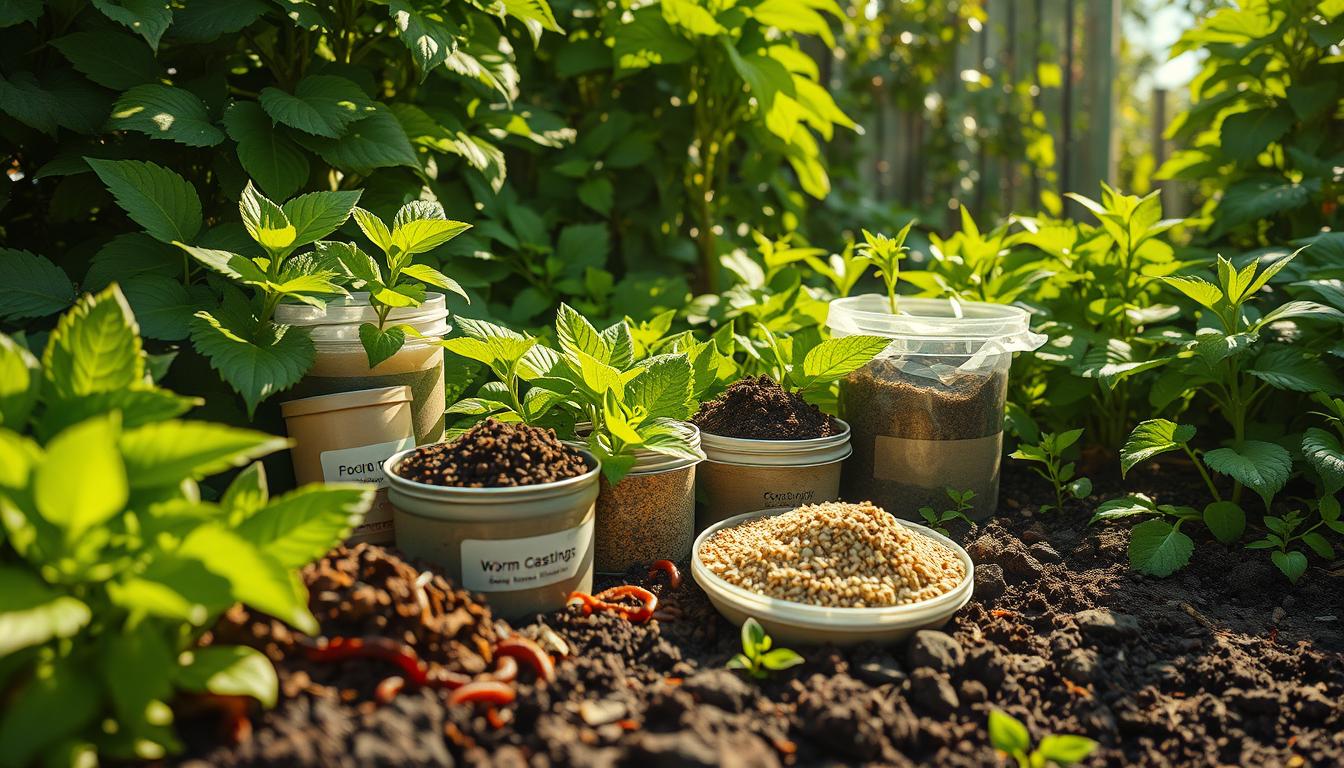As a gardener, I’ve discovered that organic fertilizers are key for healthy plants. They’re made from natural materials and are good for the planet. Using them helps my plants grow well and keeps our garden eco-friendly.
Organic fertilizers make gardening easy and effective. They help my plants stay strong and fight off diseases. In this article, I’ll share how I use organic fertilizers to keep my garden healthy and green.
Understanding Organic Fertilizers and Their Benefits
Exploring organic gardening, I see how vital sustainable plant nutrition is. Organic fertilizers are a natural, eco-friendly choice over synthetic ones. They help plants grow well and keep the ecosystem balanced. By picking plant-friendly organic nutrients, gardeners can lessen their environmental impact and grow a vibrant garden.
So, what’s special about organic fertilizers? They come from natural stuff like animal and plant waste, and minerals. This slow release of nutrients feeds plants steadily. Here are some key benefits:
- Improved soil structure and fertility
- Increased crop yields and plant growth
- Reduced environmental pollution and waste
- Support for beneficial microorganisms in the soil
Using organic gardening fertilizers is a big step towards sustainable plant nutrition. Your plants will do great, and you’ll help the environment. Next, we’ll look at the main ingredients in organic fertilizers and how they help your garden.
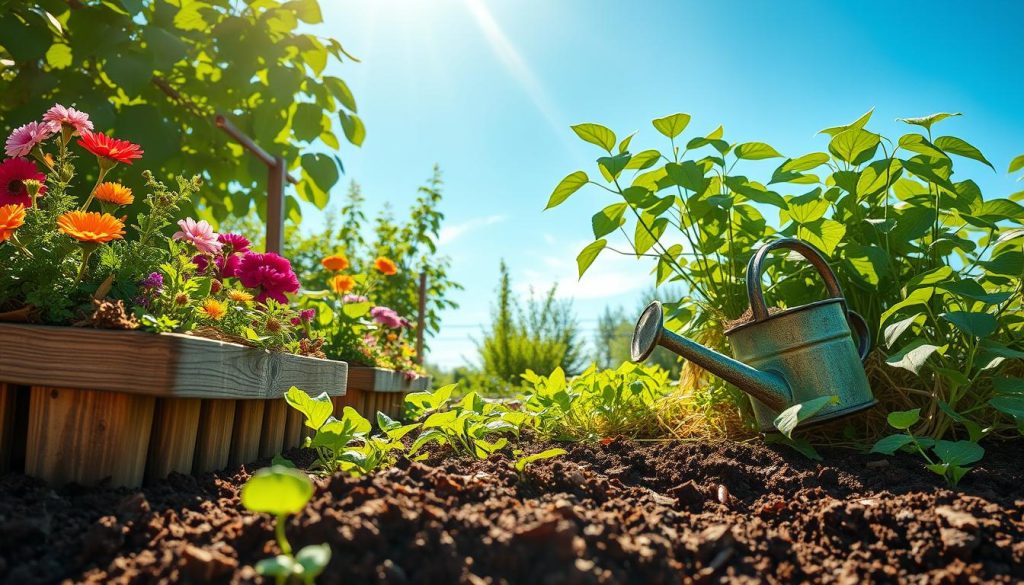
What Are Organic Fertilizers?
Organic fertilizers come from natural sources like compost, manure, and bone meal. These are full of nutrients that help plants grow well. Using organic fertilizers means less synthetic stuff and a greener gardening practice.
Why Choose Organic Over Synthetic?
Organic fertilizers are better for soil health and the environment than synthetic ones. They help create a balanced ecosystem that supports plant growth and cuts down on harsh chemicals.
Environmental Impact of Organic Fertilizers
Organic fertilizers are good for the environment. They reduce the need for synthetic fertilizers, which pollutes water and harms wildlife. They also improve soil health, cutting down on the need for pesticides and other chemicals.
| Benefits of Organic Fertilizers | Environmental Impact |
|---|---|
| Improved soil health | Reduced water pollution |
| Increased crop yields | Protection of local wildlife |
| Reduced environmental pollution | Minimized need for pesticides |
Key Ingredients in Organic Fertilizers
Exploring organic fertilizers, I’m excited to share key ingredients. These natural components promote healthy plant growth and support the environment. They are essential for chemical-free plant fertilizers.
Organic fertilizers use environmentally friendly plant food. This not only nourishes plants but also enhances soil health.
Some of the key ingredients in organic fertilizers include:
- Compost: rich in nutrients and microorganisms, making it an ideal ingredient in organic fertilizers
- Manure: high in nutrients, making it a popular choice for organic farming
- Bone meal and blood meal: providing a slow release of nutrients to plants
Compost: The Ultimate Nutrient Booster
Compost is a rich source of nutrients and microorganisms. It’s perfect for organic fertilizers. Using compost helps create a balanced and sustainable fertilizer.
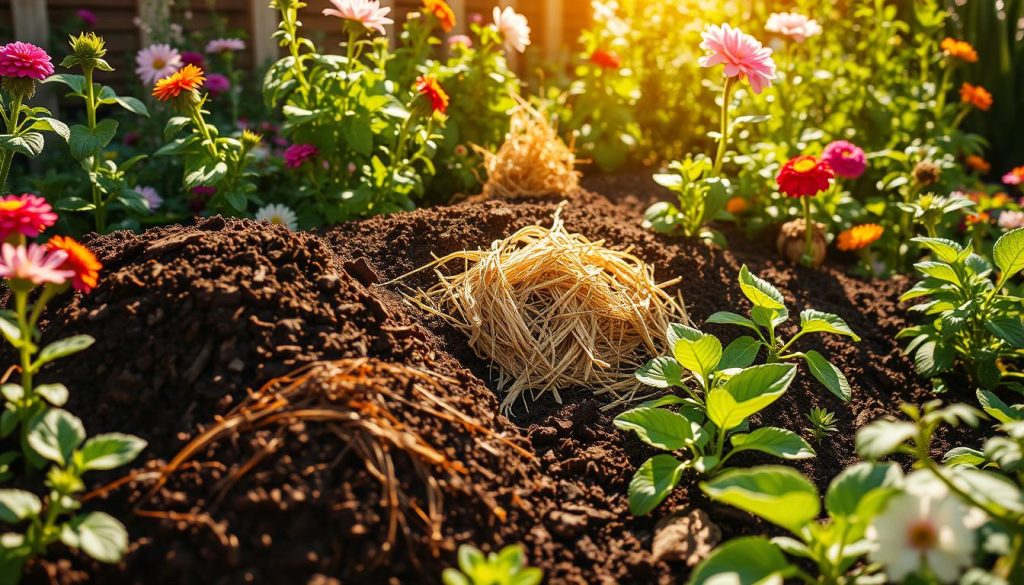
Manure: Nature’s Fertilizer
Manure is another natural ingredient high in nutrients. It’s great for making organic fertilizers. It shows how organic soil amendments can be sustainable and eco-friendly.
Bone Meal and Blood Meal: Power-Packed Nutrients
Bone meal and blood meal are key in organic fertilizers. They provide a slow release of nutrients to plants. These natural ingredients help create a chemical-free fertilizer that supports healthy growth and the environment.
How to Choose the Right Organic Fertilizer for Your Plants
Choosing the right organic fertilizer can be tough, with so many choices out there. It’s key to check your soil’s health and see what your plants need. Each plant is different, and the wrong fertilizer can harm them.
Think about your soil’s pH, nutrient levels, and what plants you have. This helps pick an eco-friendly fertilizer that fits your needs. Many organic brands offer products for various plants and soils, helping your plants grow well.
Assessing Soil Health
Before picking a fertilizer, test your soil’s pH and nutrients. Knowing this helps choose the best organic fertilizer for your garden.
Matching Fertilizer to Plant Needs
Plants need different nutrients. For instance, veggies need more nitrogen, while flowers need phosphorus. Match your fertilizer to your plants’ needs for the best growth.
Popular Organic Fertilizer Brands to Consider
Look at brands like Miracle-Gro, Espoma, and E.B. Stone. They have organic fertilizers for various plants and soils, offering natural nutrients and eco-friendly options.
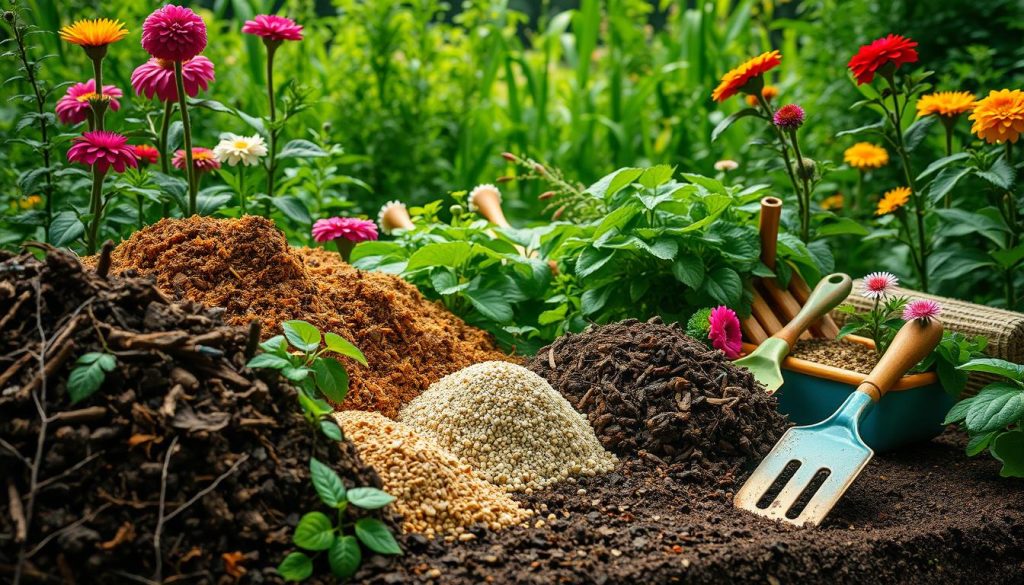
By considering these points and picking the right fertilizer, you can help your plants grow well. Always read the label and follow instructions for the best results.
| Brand | Product | Plant Type |
|---|---|---|
| Miracle-Gro | Organic Choice | Vegetables and Fruits |
| Espoma | Organic Bloom! | Flowers and Roses |
| E.B. Stone | Organic Starter | Seedlings and Transplants |
Preparing Your Garden for Organic Fertilization
To get the most out of organic gardening fertilizers, you need to prepare your garden soil. Start with soil testing to know your soil’s nutrient levels and pH. This lets you pick the right organic nutrients for your plants, helping them grow well.
Soil Testing: The First Step
Soil testing is easy, done with a DIY kit or lab test. It shows what nutrients your soil has. This helps you choose the best organic fertilizers for your plants.
Composting Basics for Beginners
Composting is key for garden soil prep. It turns kitchen scraps and yard waste into a nutrient-rich fertilizer. This natural method reduces waste and makes your soil fertile for plants.
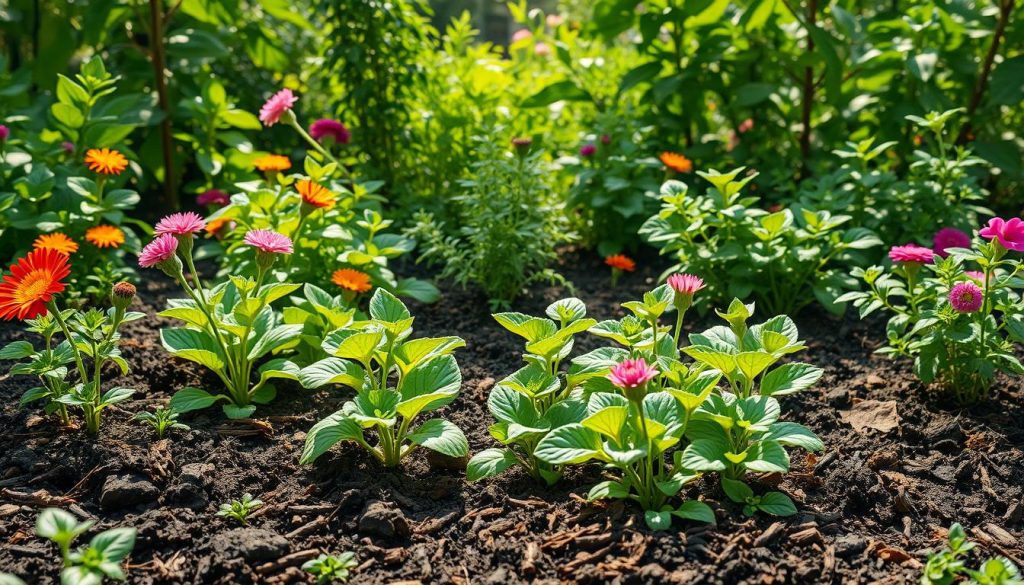
How to Create a Fertile Ground
To make your soil fertile, add compost, manure, or peat moss. These improve soil structure and fertility. Your plants will get the nutrients they need for healthy growth. Organic fertilizers and sustainable practices help your garden thrive.
| Soil Type | Nutrient Levels | pH Level |
|---|---|---|
| Clay | High | 6.0-7.0 |
| Sandy | Low | 6.0-7.0 |
| Loam | Medium | 6.0-7.0 |
Application Methods for Organic Fertilizers
Exploring organic fertilizers, I’ve learned that how you apply them matters a lot. For chemical-free fertilizers, there are a few key ways to use them. Top dressing is simple and works well. It means sprinkling fertilizer on the soil’s surface. This method lets the fertilizer slowly release nutrients, feeding my plants steadily.
Liquid fertilizers are another option, giving nutrients quickly. They can be sprayed on leaves or mixed into the soil. This is great for plants needing a fast nutrient boost. Mixing fertilizers into the soil or compost also works well. It lets the fertilizer break down and enrich the soil, feeding plants over time.
Choosing the right application method is key. For example, compost or manure is best for top dressing or mixing into soil. Liquid fertilizers are better for plants needing a quick nutrient boost. By picking the best method and using organic soil amendments, I can grow a healthy, sustainable garden. This garden benefits my plants and the environment.
- Top dressing: simple and effective for chemical-free plant fertilizers
- Liquid fertilizers: quick nutrient delivery for plants that require an immediate boost
- Incorporating fertilizers into the soil: creates a nutrient-rich environment for long-term plant growth
Understanding the different ways to apply fertilizers helps my garden thrive. With organic soil amendments and environmentally friendly plant food, I can grow a beautiful, sustainable garden. This garden is good for my plants and the environment.
Timing Your Organic Fertilizer Application
As I care for my plants with organic fertilizers, I’ve learned timing is key. The right time to apply natural nutrients can greatly impact growth. Here, I’ll share my insights on when to apply organic fertilizers for the best results.
Seasonal Considerations
When using eco-friendly fertilizers, think about your plants’ seasonal needs. Plants grow fast during the growing season and need more nutrients. Applying organic fertilizers at this time helps them grow strong and healthy.
Feeding Young Plants vs. Established Ones
Young plants need more fertilizer than older ones. I suggest fertilizing young plants every 1-2 weeks. Older plants might only need a little now and then. This way, young plants get the nutrients they need, and older plants don’t get too much.
Signs Your Plants Need More Nutrients
How do you know if your plants need more nutrients? Look for yellow leaves, slow growth, and poor fruit. These signs mean your plants aren’t getting enough nutrients. By watching your plants and adjusting your fertilizing, you can help them grow well.
- Yellowing leaves: a sign of nutrient deficiency
- Slow growth: may indicate inadequate fertilization
- Poor fruit production: can be a result of insufficient nutrients
By considering these points and applying organic fertilizers at the right time, you can have a thriving garden. Choose eco-friendly fertilizers that are full of natural nutrients. Your plants will appreciate it.
| Plant Type | Fertilization Frequency |
|---|---|
| Young Plants | Every 1-2 weeks |
| Established Plants | Occasional feeding |
DIY Organic Fertilizers: Easy Recipes
As a gardener, I’m always searching for ways to feed my plants well and protect the environment. Making my own organic fertilizers is a great way to do this. They save money and help the planet by cutting down on synthetic fertilizers.
Homemade Compost Tea
Homemade compost tea is one of my top picks. It’s simple to make and gives plants a nutrient boost. I just steep compost in water for a few days, then strain it to use as fertilizer.
Using Eggshells and Coffee Grounds
I also use eggshells and coffee grounds to enrich my soil. They add calcium and nitrogen, which are good for plants. Here’s how to use them:
- Crush eggshells and mix them into the soil to provide calcium
- Use coffee grounds as a mulch to retain moisture and suppress weeds
- Mix coffee grounds into the soil to add nitrogen and other micronutrients
Creating Your Own Fish Emulsion
Making fish emulsion is another fun DIY project. It’s made by steeping fish scraps in water, then straining and using the liquid as fertilizer. It’s packed with nutrients that help plants grow strong.
Using these DIY fertilizers helps my plants thrive while being good for the planet. Whether you’re new to gardening or have been doing it for years, I suggest trying these recipes. You’ll see the difference it makes.
| DIY Fertilizer | Ingredients | Benefits |
|---|---|---|
| Homemade Compost Tea | Compost, water | Nutrient boost, improves soil structure |
| Eggshells and Coffee Grounds | Eggshells, coffee grounds | Calcium, nitrogen, improves soil structure |
| Fish Emulsion | Fish scraps, water | Rich source of nutrients, promotes healthy plant growth |
Common Mistakes to Avoid with Organic Fertilizers
Exploring organic fertilizers, I’ve learned that mistakes can occur. Using chemical-free and eco-friendly fertilizers is great, but knowing common errors is key. One big mistake is over-fertilizing, which can harm your plants.
Over-Fertilization: A Hidden Danger
When using organic fertilizers, remember that too much is bad. Over-fertilizing can upset the soil’s nutrient balance, hurting your plants. Always follow the package instructions and start with small amounts. Gradually increase as your plants need more.
Ignoring Soil pH Levels
Soil pH levels are vital for organic fertilizers to work well. Not checking pH levels can cause nutrient deficiencies and poor growth. Test your soil pH to ensure your plants get the nutrients they need, making your fertilizers more effective.
Not Monitoring Plant Responses
Not watching how your plants react to fertilizers can lead to problems. Keep an eye on your plants to adjust fertilizers as needed. This way, you ensure your plants get the right nutrients, using organic and eco-friendly options.
Success Stories: My Favorite Plants Thriving on Organic Fertilizers
I’ve grown many plants with organic fertilizers, and the results are amazing. My garden is full of delicious food and supports local wildlife. It’s a haven for pollinators and beneficial insects, thanks to natural nutrients and eco-friendly solutions.
High-Yield Vegetables
My vegetable garden is a big success. I use compost and organic fertilizers to grow tomatoes, cucumbers, and carrots. The right mix of nutrients helps my plants grow strong.
Stunning Flower Gardens
My flower garden is also a hit. Eco-friendly fertilizers make it colorful and attract pollinators. It’s a beautiful part of my outdoor space, thanks to organic fertilizers.
Vibrant Indoor Plants
My indoor plants also do well with organic fertilizers. They stay healthy and vibrant, even in winter. Organic fertilizers work for all types of plants, indoors and out.
| Plant Type | Organic Fertilizer Used | Results |
|---|---|---|
| Vegetables | Compost and organic fertilizers | High-yield harvest |
| Flowers | Eco-friendly fertilizer solutions | Stunning display of color and beauty |
| Indoor Plants | Natural plant nutrients and eco-friendly fertilizer solutions | Healthy and vibrant plants |
Organic Fertilizers and Pest Management
Exploring organic gardening fertilizers has shown me how vital pest management is. It keeps our gardens healthy and balanced. By using organic methods, we attract good bugs that fight pests. This way, we avoid harmful chemicals and help our gardens grow better.
Here are some ways to keep your garden balanced:
- Attracting beneficial insects, such as bees and butterflies, by planting a diverse range of flowers and herbs
- Using natural pesticides, like neem oil and diatomaceous earth, to control pests without harming beneficial insects
- Practicing good garden hygiene, such as removing weeds and debris, to prevent pest infestations
By using these methods, we can cut down on harmful chemicals. This makes our gardens better for the environment. It’s key to using organic fertilizers and keeping our gardens healthy.
Understanding Nutrient Ratios in Organic Fertilizers
Exploring organic fertilizers, I’ve learned how vital nutrient ratios are. Knowing the N-P-K ratio in chemical-free fertilizers is key. It helps plants grow well and supports green practices.
Choosing the right organic soil amendments is crucial. Plants have different nutrient needs. Some need more nitrogen for leaves, while others need phosphorus for roots. Tailoring nutrient ratios helps plants grow best.
Some key considerations when it comes to nutrient ratios include:
- Nitrogen: essential for leaf growth and development
- Phosphorus: crucial for root development and flower production
- Potassium: important for overall plant health and resistance to disease
Understanding nutrient ratios helps create a thriving garden. Whether using chemical-free or eco-friendly fertilizers, the goal is to nourish plants. With the right organic soil, you’ll enjoy a lush harvest and feel good about your eco-friendly choices.
| Plant Type | Nitrogen | Phosphorus | Potassium |
|---|---|---|---|
| Leafy Greens | High | Medium | Low |
| Flowering Plants | Medium | High | Medium |
| Fruiting Plants | Medium | Medium | High |
Conclusion: Embracing Organic Fertilizers for a Thriving Garden
Reflecting on my organic gardening journey, I’m deeply grateful for organic fertilizers. They’ve not only fed my plants but also connected me to the earth. This has led to a greener gardening approach.
Using eco-friendly fertilizer solutions has shown me amazing results. My plants are now vibrant and healthy, all without harsh chemicals. This journey has been incredibly rewarding. I want to share this with all gardeners.
It’s important to focus on sustainable gardening and lessen our environmental impact. Choosing organic fertilizers is a big step in the right direction. With some knowledge and the right methods, anyone can make a green, productive garden.

